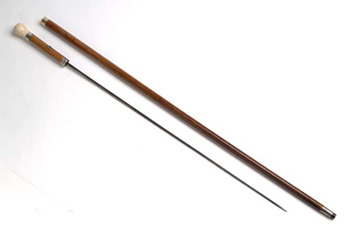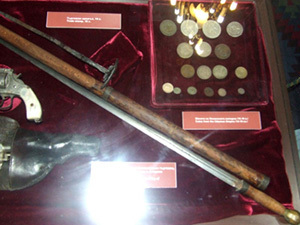Sword-stick (sword-cane)
I took this rather poor picture of a sword-stick in a Bulgarian museum. I think this is a very fascinating weapon, a wolf in sheep’s clothing, as walking sticks today express vulnerability and venerability. Bulgaria has a history of concealment having been invaded and ruled by Greeks, Romans, Byzantines and Ottoman Turks. Bulgarians nod their heads to indicate ‘no’ and shake their heads to say ‘yes’ – a tradition which I have yet to get a definitive answer on how it happened, the main story I’ve heard is it grew out of resistance to Ottoman rule to hide true information. So a sword-stick would have been a perfect weapon during the years of resistance.
A little dabbling online shows sword-sticks were popular fashion accessories a in the 18th and 19th centuries and also self defense weapons when it became less socially acceptable to openly wear swords.1
 Wikimedia Commons
Wikimedia CommonsHowever they have not completely disappeared into the pages of history as I found a high end sword-stick maker in South Africa (http://www.swordcane.com/mk3b.htm) who ship all over the world. This is interesting because sword-sticks are not legal in many countries (but so long as you never use it I guess no one has to know and if you were very old you could always try claim ignorance…).
One country with a very old tradition of this type of weapon is Japan. Their sword-canes are called “Shikomizue” and from the image below one can see how camouflaged they would look – just like a regular walking cane.
 Wikimedia Commons
Wikimedia Commons
1 https://en.wikipedia.org/wiki/Swordstick




